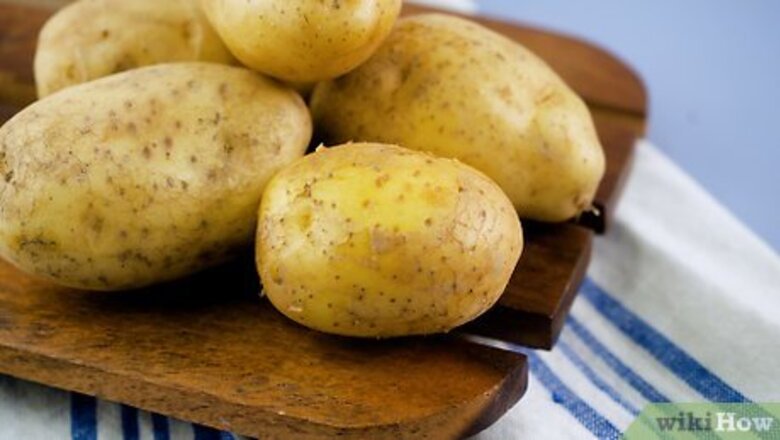
views
- Potato peels contain lots of nutrients like fiber, so keep the peels on to reap their benefits.
- Keep the peels on waxy or new potatoes, as their skin is thinner. Or, leave on the peel to add texture and heartiness to boiled, roasted, and mashed potatoes.
- Peel potato skins on floury potatoes with thick skins like Russet potatoes. Or, remove the skin if you want super creamy mashed potatoes and soups.
When to Leave the Skins On Potatoes
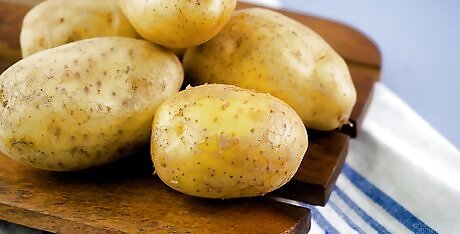
Keep the peels on potatoes to reap the nutritional benefits. Potato peels are full of fiber, which helps boost your digestive health. So, leave the peels on regardless of the type of potato you’re eating and the dish you’re making to add extra fiber content into your diet. Potato peels also contain a good source of iron, zinc, calcium, vitamin B, and vitamin C. If you can’t stomach the texture of potato peels, don’t worry! The flesh of the potato is full of beneficial vitamins like vitamin C and potassium. Note: Wash your potatoes under lukewarm water and scrub the skin with a vegetable brush, regardless if you’re removing the peel or not. This gets rid of dirt, bacteria, and pesticide residue. Then, cut off any scabs, sprouts, green spots, or bruises.
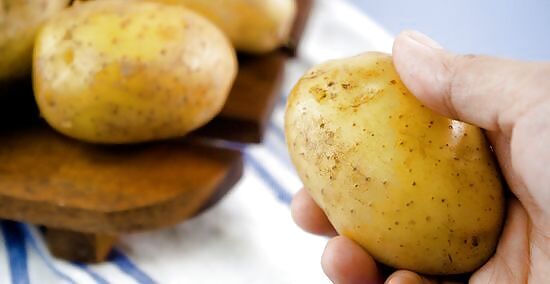
Leave the peels on if you're cooking waxy or new potatoes. Waxy potatoes, such as yellow or red potatoes, have thinner peels and more flavorful flesh. Small new potatoes, which are the first of the season, are flavorful and usually too small to peel easily. Keep the peels on these spuds since they don’t typically get in the way of the texture or flavor of your dish. New potatoes are great when prepared simply. Roast the tiny potatoes or steam them to preserve their delicious flavor.
Keep on the peels for crispy baked, roasted, and pan-fried potatoes. If you want your potatoes to have a satisfying crunch when you roast them or make baked potatoes, coat the outside with olive oil and a pinch of salt and set them in a hot oven. Or, pan-fry your spuds in a pan of hot vegetable or sunflower oil.
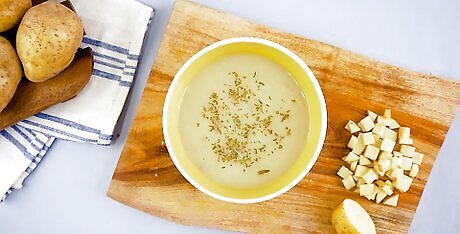
Leave the peels on to add a rustic texture to soups or chowders. Thick soup, creamy chowders, and chunky stews typically have a heartier texture if you leave the peels on the potatoes. To make the dishes easier to eat, keep the potatoes about 1 inch (2.5 cm) in size or smaller. When making creamy soups, opt for starchy potatoes that break apart easily, like Russet, Yukon Gold, and yellow potatoes. For thick stews and chowders, go for potatoes that hold their shape better, like red, purple, and fingerling spuds. If you use potatoes with thicker peels, like Russets, cut them into even smaller pieces so you don't get large bites of skin.
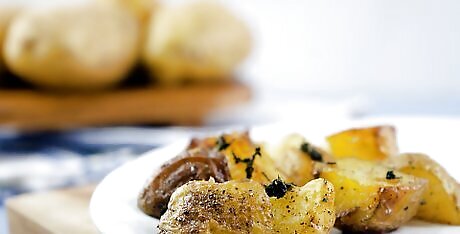
Keep the peels on if you want a more filling side dish. Whether you're making scalloped potatoes, roasting potatoes, whipping up mashed potatoes, or frying up french fries, cook them with the peels on. You'll find that they're heartier than if you peel the potatoes. The peels also give the sides a more rustic appearance.Tip: If you're making baked potatoes, leave the peel on to get the best texture. When leaving the peels on, it’s especially important to cook the potatoes thoroughly so the peels are tender.
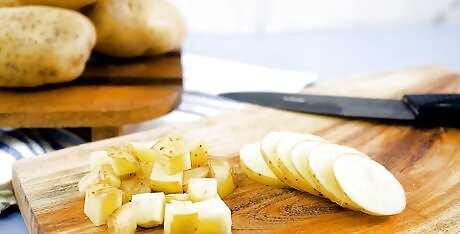
Avoid peeling potatoes if you're trying to save time in the kitchen. If you're in a time crunch, peeling your potatoes is an extra step that can add to your cooking time. If you and your guests don’t mind the texture of peels, use any potato to make your dish. Or, choose a waxy or new potato with thin skins that are less noticeable. As always, make sure you clean your potatoes and trim away blemishes with a small paring knife before you cook them.
When to Peel Potatoes

Remove any green skin on potatoes. Potatoes can start to turn green if they’re exposed to light for a long time. This indicates that the potato is producing solanine, which can be toxic and make the potato taste bitter. Simply peel the potato or cut off any small spots of green before cooking your spuds. Warning: Do not serve green potatoes to children, even if you cut off the green spots. Children are more susceptible to the toxin. If the potato is covered in green spots, throw it out. To prevent green spots from forming, store your potatoes in a cool, dark, and dry place that gets good air circulation.
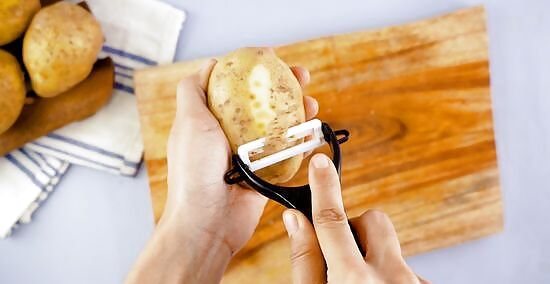
Remove the peel if you're cooking floury potatoes. Floury or starchy potatoes like Russet and white potatoes tend to have a thicker peel. If these spuds have a chewy or firm texture that’s too much for you, simply peel off the skin whether you’re boiling, roasting, mashing them, or adding them to soup.Tip: Instead of throwing your potato skins out, make crispy, chip-like potato skins! Toss the skins in olive oil and salt and set them in your oven or air fryer for 10 minutes at 400º F (204º C). Compost the potato skins or throw them away if you’re not using them.
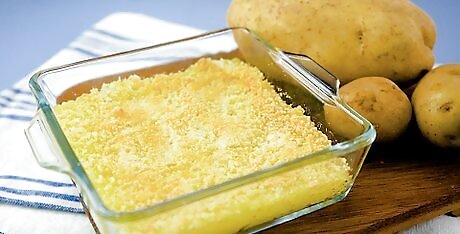
Cut off the skin if you want very creamy and tender dishes. To make the smoothest mashed potatoes, peel the spuds before you purée them. Or, if you want roasted potatoes to melt in your mouth, remove the peels.Tip: Peeled potato dishes tend to have a more refined and sleek appearance. If you’re trying to impress a crowd, remove the skins. If you're making potato salad or another cold potato dish, remove the peels so they don't separate when you boil them.
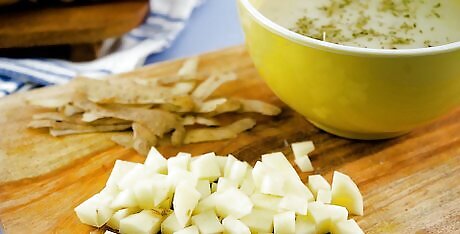
Strip the skins if you're blending the potatoes into a soup. If you’re after smooth, velvety stews and chowders with an even consistency, peel your potatoes. Removing the skins also ensures you get the silkiest consistency when you make a vichyssoise or bisque. If you don’t like the texture of potatoes in soup even when the peels are off, purée them. This gets rid of any chunky pieces of potato.

Peel potatoes if you’re worried about pesticides and bacteria. Rinsing and scrubbing potatoes under cool water is an effective way to get rid of most dirt, germs, and pesticides on your spuds. If you're concerned about ingesting any leftover residue that’s not washed off, peel the potatoes before you cook them. Alternatively, grow your own potatoes to limit pesticide use. Or, only shop for organically grown spuds. Note: Always wash your potatoes, even if you’re going to peel them. This prevents bacteria or pesticides from entering the potato.


















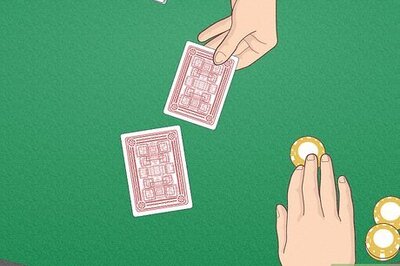
Comments
0 comment